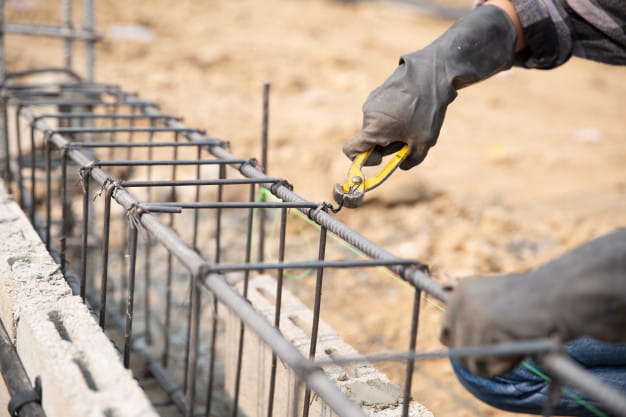Steel Reinforcement Bar : Benefits & Types
- Concrete Cost Estimator
- Concrete Continuous Footing
- Landscape Bidding and Estimating
- Construction Cost Estimating
- Concrete and steel cost estimation
- Construction Cost Estimate Breakdown
- Construction Estimating Worksheet
- Home Construction Cost Estimate
- Estimate Pricing Sheet
- Sheet for General Contractor
- Construction Cost Estimate
- Labor Materials Cost Estimator
- Masonry Estimating Sheet
- Sheet for Building Contractor
- Construction Schedule Bar chart
- General Cost Estimator Sheet
- General Construction Estimate
- Building and Road Estimating Sheet
- Detailed expense estimates
- Door and Window Takeoff Sheet
- General Construction Cost Estimating Sheet

Steel reinforcement bar belongs to a stainless steel rebar that is applied as a tension device in reinforced concrete & reinforced masonry structures to increase its strength against strain.
It comprises of superior tensile strength and withstand fatigue efficiently as compared to ordinary steel rebar.
Concrete is stronger against pressure, but it contains poor tensile strength.
Stainless steel is included in concrete with normal exposure to chlorides in soffits, edge beams, diaphragm walls, joints and structures.
Steel Rebar mainly enhances the elasticity of the structure surface. It is frequently deformed with ribs, spaces to create greater superior bond with the solid concrete and give protection against slippage.
Standards Of Steel Reinforcement Bars
The main stainless steel rebar standards used today are BS 6744 (UK) [28] and ASTM A955 (USA) [29], although there are others types like XP135014 (France). Other countries just use the carbon steel standard, sometimes with small alterations, like SIA 262 (Switzerland) or DIN 488(Germany).
Steel Reinforcement Types:
- Hot Rolled Deformed Steel Bars
- Cold Worked Steel Bars
- Mild Steel Plain Bars
- Deformed Steel Bars
- Prestressing Steel Bars
Also Read: Detail Guidelines About Placing and Binding Reinforcing Steel
HOT ROLLED DEFORMED STEEL BARS:
Hot-rolled deformed steel bars are popular type of reinforcement for standard RCC structures. Hot rolling is completed in the factories to provide deformations on the surface.
COLD WORKED STEEL BARS:
A cold-worked reinforcement bar is formed by allowing the hot moved steel bars to encounter cold working. With this system, the bars will go through twisting and drawing. The method is done at room temperature. The cold worked steel bars don't undergo a plastic yield and contain less flexibility when contrasted and hot-rolled bars.
MILD STEEL PLAIN BARS:
Mild steel bars are useful for tensile stress of reinforced cement concrete slab beams etc, in RCC work. These steel bars are plain in surface and contains round segments with the diameter of 6 to 50 mm. Here, the length of steel bars is high and they are cut and twisted efficiently without any problem.
DEFORMED STEEL BARS:
Deformed reinforcing steel bars belong to another type reinforcing steel bars. Generally, its surface contains ribs with three types of shapes: winding shape, herringbone shape and crescent shape. Deformed reinforcing steel bars with high quality are used in the strengthened solid structure as well as applied as a prestressed strengthening bar.
PRESTRESSING STEEL BARS:
Prestressing cables or tendons are available in various standards with several wires of average 7 wire strand containing seven wires hectically spun together into a strand. These wires are cold drawn and include remarkably high tensile ultimate strength. Due to strong rigidity, they can efficiently prestress concrete after encountering various losses. They are used in prestressing solid similar to RCC braces of scaffolds.
The steel reinforcement concrete offers the following benefits:
- Strong resistance capacity against corrosion.
- The life cycle cost for concrete structures is curtailed significantly.
- Good strength.
- It is not dependent on the high alkalinity of concrete for protection
- Strong weldability for common rebar grades.
- It can be easily recycled in due course.
- Efficient ductility for common rebar grades (capable of 3d U-bends).
- Coatings are not required to chip, crack or degrade.
- No coating damage to repair.
- No "exposed" cut ends to coat or cover.
- Resist shipping, handling, bending.
- It is used selectively for high risk elements economically.
- Strong high- and low-temperature mechanical properties of common rebar grades.
- The use of concrete cover is minimized.
- Concrete sealant like Silane can be reduced.
- It minimizes maintenance and repair.
- Application of concrete calculator
- Roofing Calculator can streamline the roof estimating process
- House construction cost calculator
- Engineering column design excel spreadsheet
- Material Estimating Sheet with Excel
- Materials List and Cost Estimate Worksheet
- Concrete Slab Estimating Calculator Sheet
- Common types of foundations for buildings
- Online calculation of construction materials
- Estimating with Excel for the Small Contractor
- Concrete Beam Design Spreadsheet
- Virtual Construction Management app for construction
- Autodesk’s Project Skyscraper
- Reed Construction’s Reed Insight
- Manage your construction project documentation
- Costimator, the popular cost estimating software
- On Center Software for construction professionals
- Free Construction Estimating Software
- Plumbing Calc Pro
- Cost Estimate Worksheet
- HVAC Piping Quantity Takeoff Worksheet
- Construction Estimating Software Sheet
- Estimate Cost Templates
- Construction Punch List
- Construction cost estimating template consisting estimating basic
- Gantt Chart Template for Excel
- Download Civil Engineering Spreadsheets with Verification
- The Building Advisor Estimating and Budgeting Worksheet
- Spreadsheet for design of concrete bridge
- Construction Estimating Software Free









